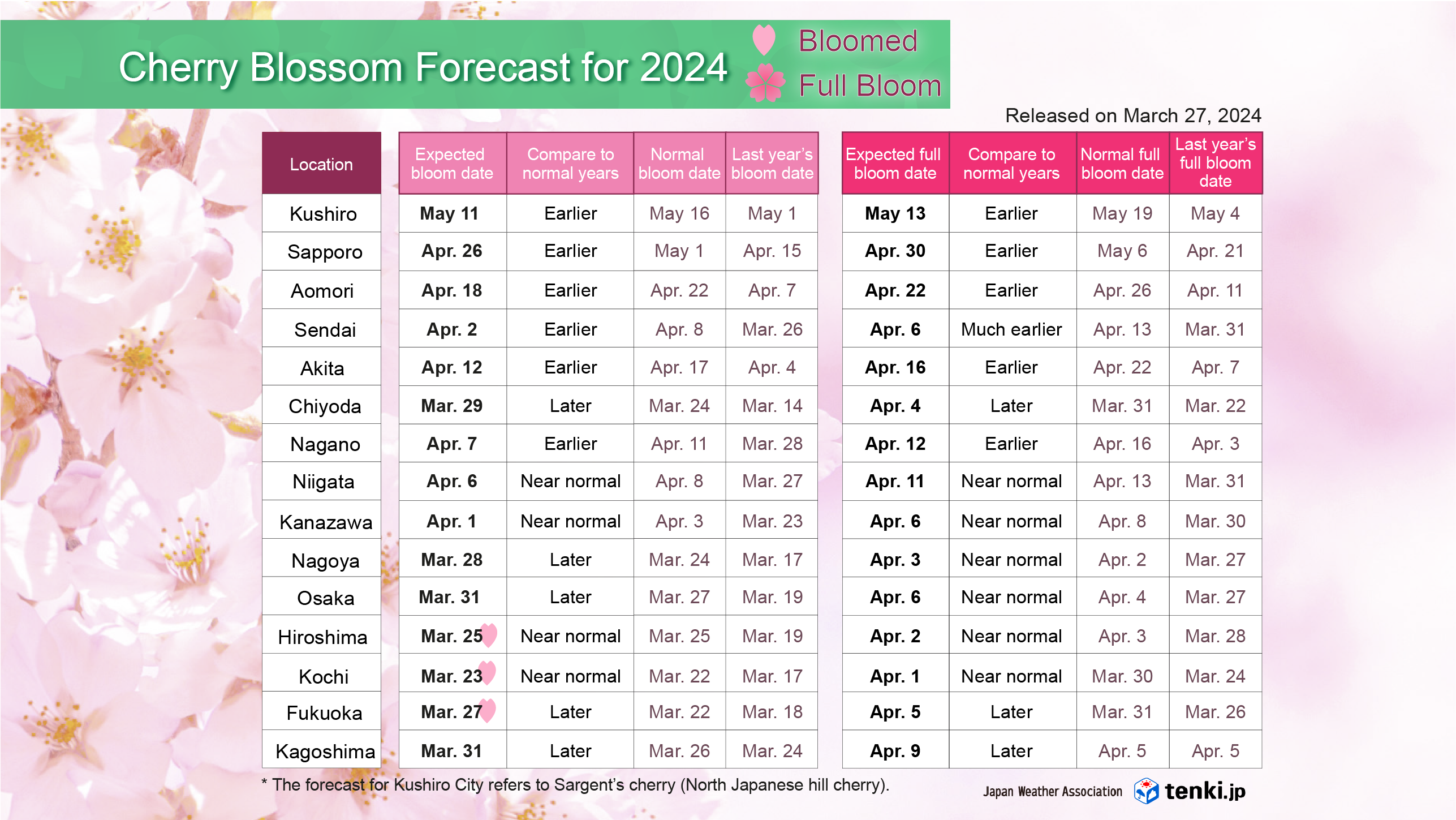Cherry Blossom and Full Bloom Forecast for 2024(Part 4)
Tokyo expected to see blossoming later than normal, possibly on the 29th
Press Release
Japan Weather Association (JWA) released the cherry blossom blooming and full bloom forecast (part 4) at observation points nationwide on Wednesday March 27, 2024
Cherry Blossom Forecast Map

Bloom Forecast Dates (Major Locations)

Trend of Blossoming and Full Bloom
Blooming is just around the corner, but the transition to spring is slow.
Since March, temperatures across the nation have been lower than usual, though with some areas experiencing a temporary surge of spring warmth surpassing 20℃ around the 16th to 17th. However, following that, days reminiscent of winter chill and rainy weather persisted, leading to a slower growth of cherry blossom buds than anticipated.
Consequently, many areas in Western and Eastern Japan are experiencing a significant delay in blossoming compared to last year, with some locations being more than three days later than average.
However, during this weekend, around the 30th to 31st, an early taste of summer warmth is expected in some areas, with temperatures approaching 25°C. Even in regions of Western and Eastern Japan where blossoming has been delayed, many are expected to bloom by this time.
Furthermore, from April onwards, temperatures in Northern Japan are expected to be higher than average. Therefore, cherry blossom buds are anticipated to grow well, and both blossoming and full bloom are likely to occur earlier than usual in Northern Japan.
This year’s cherry blossoms began blooming in Sukumo City, Kochi Prefecture on March 12th*, and according to sample trees from the Japan Meteorological Observatory, they bloomed in Kochi City on the 23rd. As of 12:00 on the 27th, reports of blossoming were received from 11 cities including Fukuoka City and Kumamoto City.
As April begins, the cherry blossom front will continue to move northward. It is expected to blossom in Sendai on April 2nd, in Akita on the 12th, and in Aomori on the 18th. By late April, it will reach Hokkaido, with blossoming expected in Sapporo on the 26th.
Furthermore, it is expected that the cherry blossom full bloom will start from Miyakonojo City on March 29th*. However, full bloom by the end of March is expected to be limited to some early-blooming regions. As April begins, full bloom will be observed across various regions, and in early April, there will be a widespread full bloom rush from Kyushu to Southern Tohoku.
*The information for Sukumo and Miyakonojo are not from sample trees of the meteorological observatories, but from independent observation points of JWA.
The Appearance of Cherry Blossom Buds

The cherry blossom and full bloom forecast for all 83 locations is available on tenki.jp, a weather forecast media site below operated by JWA.
https://tenki.jp/sakura/expectation/
Cherry Blossom Forecast
For more detailed information about JWA’s Cherry Blossom Forecast, please find the link below.
https://www.jwa.or.jp/english/service/seasonal-news-cherry-blossom-forecast/
【Description of words】
Normal: Average of 1991-2020
Much earlier: 7 or more days earlier than normal
Earlier: 3 to 6 days earlier than normal
Near normal: 1 or 2 days earlier or later than normal
Later: 3 to 6 days later than normal
Much later: 7 or more days later than normal
Originally released in Japanese: 2024/3/27
Reference material
Frequently asked questions regarding cherry blossom forecast
Q1: What are the criteria for the flowering and full bloom dates?
A1: The criteria are the same as those used by Japan Meteorological Agency. The flowering period starts the first day when 5 to 6 or more flowers have started to bloom on the designated observation tree (i.e. sample trees), and the full bloom date is the first day when more than 80% of the buds have opened on the sample trees.
Q2: How many locations are expected?
A2: We announced forecasts for 83 locations nationwide. The forecast locations consist of 53 sample trees observed by each local meteorological observatory and 30 locations where observation data are obtained from cooperating agencies such as municipalities/local governments and parks.
Q3: What are the methods and characteristics of the Japan Weather Association’s cherry blossom forecast?
A3: We use our proprietary forecasting model that focuses on the temperature trends from autumn onwards, which significantly influence the growth process of cherry buds. Our forecasts are based on accurate observation data from sample trees at local meteorological observatories and cooperating agencies, emphasizing meteorological principles. Japan Meteorological Association has been conducting cherry blossom forecasts since 2007, making this year the 18th year of our endeavor.
Q4: What data are used for forecasting cherry blossoms?
A4: The following data are used.
- Temperature observation data from the previous autumn to the forecast date
- Temperature forecast data from the forecast date to the blooming period (from Japan Weather Association’s point forecasts and long-term forecasts).
The temperature from the previous autumn to spring significantly influences the cherry blossoming period. Cherry buds form during the previous summer and then enter dormancy. Exposure to a certain period of low temperatures during winter breaks this dormancy, and the buds grow and bloom with rising temperatures. It is believed that higher temperatures promote faster bud growth and earlier blooming.
PDF DOWNLOAD:Cherry Blossom and Full Bloom Forecast for 2024(Part4)


